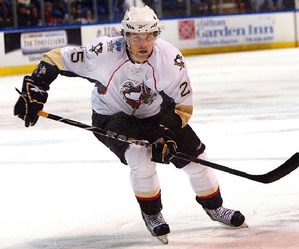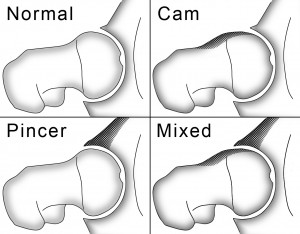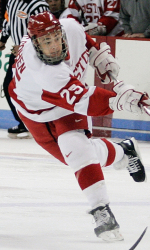Part 1 of this series described anatomical asymmetries that all humans have, and how they can lead to predictable patterns and functional asymmetries. Part 2, below, will dive into how these patterns directly affect hockey performance and how they may contribute to common hockey injuries.
Influence on Hockey Performance
These positions are not inherently harmful. In fact, everyone should possess the ability to get into and out of these positions, bilaterally. Problems arise when an athlete gets stuck in a pattern and is unable to achieve the reciprocal position. This causes a shift in neutrality and increases the likelihood the athlete will need to push past joint end-range to achieve a functional outcome. Specific to skating in hockey:

Application to Common Hockey Injuries
Interestingly, femoroacetabular impingement (FAI) which affects the overwhelming majority of elite level hockey players involves a loss of hip flexion, adduction, and internal rotation. While the two types of FAI, CAM and pincer, differ in the site of bony overgrowth, it’s clear that these injuries can become worse over time as players continue to push through joint end range and force bone on bone contact. Referring to the list above, it’s apparent that a left hip positioned in a state of flexion will increase the probability that a player will drive through end range hip flexion on that side; likewise, a right hip positioned in adduction and internal rotation provides a mechanism for excessive bony contact on that side. In other words, this same pattern provides a mechanism through which hockey players can develop FAI on both sides.

Similarly, because the left hip is positioned in a state of external rotation and abduction, the adductors are positioned long. As the stride leg is extended, these adductors are forced to decelerate the leg near their end-range, making it more likely that these muscles will become overstretched/strained and tear. In addition to the compensatory SI joint movement that the forward stride can create on the left side, driving through end-range external rotation can also cause a forward migration of the femoral head within the joint, causing excessive strain and laxity across the anterior hip capsule. Both adductor strain and anterior hip capsule laxity are common causes of “groin pain” in hockey players. Laxity in the capsule also allows for excessive accessory motion within the joint, which can cause labral damage and eventual osteoarthritis.
On the opposite side, the right adductors are positioned short and can become extremely dense and fibrotic. The predominant thought currently is that sports hernias are caused in large part because of a tug of war across the pubic symphysis between dense adductors and weak abdominals. The adductors progressively win this battle in an erosion-like fashion, which causes a fraying of the structures in the area of the superior surface of the pubic bone. Not surprisingly, sports hernias are more commonly found on the right side.
Naturally, early recognition is key. Indeed, while not every hockey player I’ve tested falls into one of PRI’s patterns, every hockey player with a history of hip injuries that I’ve tested does.
Subjectively, players may report having a more difficult time turning or crossing over to one side compared to the other. Similarly, they may have a preference for or feel more explosive when stopping and/or pivoting on one side compared to the other. While structure clearly influences function, function similarly influences structure. Simply, as players bias toward a certain position or pattern, all of their body’s systems, most notably their nervous and musculoskeletal systems, will adapt to the stresses. Often times, a small bias can snowball into a glaring asymmetry later down the road. This process may take years to develop, but can have dire consequences on a player’s health, performance, and career longevity.
Superimposed Occupational Biases
The discussion on structural and functional asymmetries is further complicated by occupational biases. In this sense, “occupation” simply refers to the asymmetrical patterns that players of different handedness and positions perform regularly throughout their seasons. For example, a right-handed player will likely perform THOUSANDS of high velocity, high power rotations toward the left (think slap shot) that they will not perform toward the right during a season. A goalie will likely bias toward a side-bent positioned on his stick side. These occupational tendencies are superimposed upon the asymmetries discussed above, and can help alleviate or further exacerbate some of the aforementioned consequences.

Wrapping Up
In addressing these issues, it’s necessary to keep the player’s injury history, current structural and functional presentation, and current and future occupational demands in mind. Often times, it is wise address asymmetries secondary to a loss of joint neutrality first, as it is impossible for muscles to function optimally if they are positioned poorly. Using repositioning techniques from PRI, typically breath-driven exercises involving asymmetrical targeting of specific muscles, can help restore and reinforce neutrality, and interrupt a downward spiral of compensatory adaptations. The off-season is an appropriate time to assess players for these imbalances, and to increase the volume of strategically asymmetrical exercises. Players should be monitored periodically throughout the season to help minimize the cumulative damage a season of play from a non-neutral position can create. Ultimately, following this approach can help fend off many of the acute, progressive, and chronic non-contact injuries players face throughout their careers.
To your success,
Kevin Neeld
Please enter your first name and email below to sign up for my FREE Athletic Development and Hockey Training Newsletter!